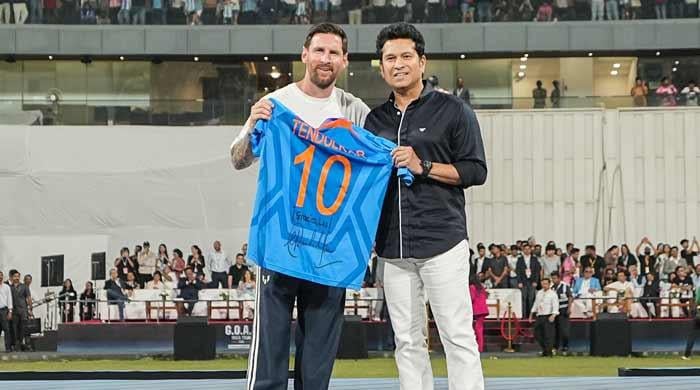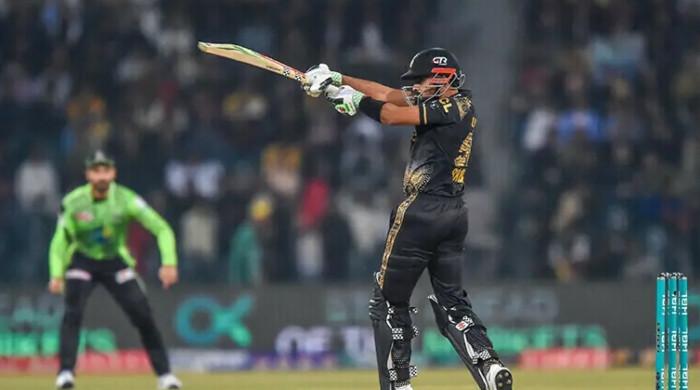Pakistan-made Fifa 2025 ball receives global acclaim
Sam Handy, Adidas' general manager for football, describes ball as culmination of 18 months of meticulous development
June 16, 2025

As the Fifa Club World Cup 2025 kicks off in the United States this weekend, all eyes aren't just on the competing teams but also on a crucial piece of equipment: the official match ball.
Unveiled earlier this year by Adidas, the Fifa Club World Cup 25 Pro Ball is garnering significant attention not only for its striking stars-and-stripes design but also for its remarkable performance, advanced engineering, and notably, its "Made in Pakistan" label.
Sam Handy, Adidas' general manager for football, described the ball as the culmination of 18 months of meticulous development. The aim, he stated, was to create something "bold, loud, iconic—and unmistakably American."
However, behind its patriotic aesthetic lies a testament to Pakistan's manufacturing excellence and high-performance engineering, with the ball proudly produced in the South Asian nation.
Beyond its origins, the 2025 Club World Cup ball also marks a step towards greater sustainability as it is crafted entirely from polyurethane, this iteration is composed of 61% polyurethane, 30% recycled polyester, and 9% viscose, unlike previous versions.
It also features Adidas’ innovative PRECISIONSHELL technology — a 20-panel, thermally bonded structure with strategically placed debossed grooves designed to improve airflow control and enhance flight consistency.
This construction is carried out in Pakistan, where the majority of the world’s footballs are manufactured.
Testing conducted at Loughborough University, a leading sports research institution in the UK, demonstrated the ball’s superior performance.
Using both human players and a robotic kicker, researchers compared the new Adidas model with balls from the Premier League (Nike Flight), Carabao Cup (Puma Orbita 1), and FA Cup (Mitre Ultimax Pro).
While robot testing showed similar speed and spin across all models, player testing revealed “noticeable differences,” according to Professor Andy Harland, who oversaw the analysis.
Players achieved their fastest strikes and higher spin rates with the Club World Cup ball—one even recorded more than double the spin compared to the Nike ball. One player remarked the ball “hits truer for professionals,” suggesting its design caters well to high-level, precision-based play.
Players observed that the ball felt firmer and had a smaller sweet spot, demanding more precise contact. However, they appreciated its consistency during open play, particularly for delivering long, accurate ground passes.
Despite the limited sample size, all three players registered their fastest strikes using the Club World Cup ball. “It hits truer for the professionals,” one player remarked afterward.
“You had to hit it more precisely,” the players noted, highlighting that the Club World Cup ball has a smaller ‘sweet spot’ compared to others.
In contrast, robot testing—which Harland explained “should give a near-identical kick each time” due to the “fixed” leg speed and ball placement—did not show the Club World Cup ball as the fastest.
The players also described the distinct feel when striking the ball: “Especially the Adidas (Club World Cup) ball, that felt rock-hard,” one player said. “It has no grip. Because you have the little grooves, you spin it more,” another added.
Two players shared a similar verdict on where it excels: “Probably better in open play. It would be good to hit a long pass with, a grasscutter (a long pass, kept low to the floor) would be perfect.”
All the balls were manufactured in Pakistan, which produces the majority of the world’s footballs. The distinct construction of the Club World Cup edition is the reason players notice such differences when kicking it.
According to Adidas, the high-grade butyl bladder inside the ball contributes to shape retention and flight stability. The company is so confident in the durability that it offers a two-year shape guarantee.
The ball also includes a motion sensor, sending data 500 times per second to aid in semi-automated offside decisions, player tracking, and touch-point identification—demonstrating the merging of sport and smart technology.
This isn’t Adidas' first foray into high-tech footballs, but the Club World Cup 25 Pro Ball represents a significant evolution from past models like the Fevernova from the 2003 Women’s World Cup and the Questra from the 1994 tournament.
Back then, balls were hand-stitched and made from multiple materials. Since 2004, Adidas has shifted to thermal bonding, with the new panel designs now allowing for unprecedented aerodynamic precision.
According to Loughborough testing lead Ieuan Williams, ball design has evolved to a point where aerodynamics take precedence over symmetry.
“People started to go, ‘Well, these don’t have to be regular shapes any longer. We can do crazy things with panels’,” he says. “There’s been a bit of a readjustment, and now we need to make sure that the ball flies properly again, which has made a load of investment in that.”
Ultimately, Adidas has broken from the tradition of simply repainting an existing model. The Club World Cup ball isn’t just a visual upgrade—it’s a technical overhaul, built for modern football.
With 63 matches on the horizon, the ball’s real-world performance will be under close scrutiny. But so far, early signs suggest that this Pakistani-made marvel is ready to deliver on the biggest stage.









